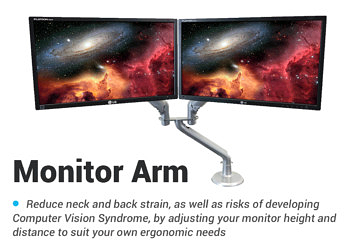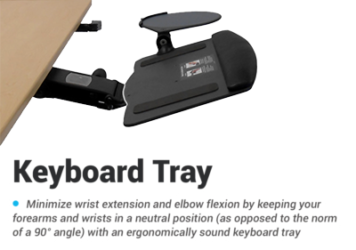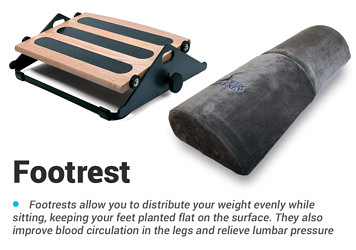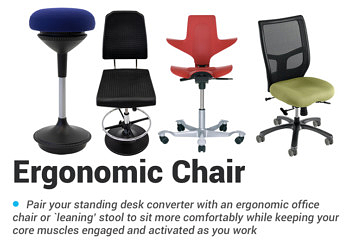Ergonofis Shift Standing Desk Review
- Lab tested
Like most reviews sites, our editorial staff and laboratory testing expenses are partially offset by earning small commissions (at no cost to you) when you purchase something through those links. Learn More

Overview
| Review Summary |
Coming from the longest established standing desk company based in Canada, Ergonofis, the Shift is their more pedestrian desk model, as compared to their Sway and Alive desks that feature solid wood tops. It does offer a unique laminate surface that feels nice to the touch, though it doesn’t have some of the features that the highest-quality, price-comparable desktops made in the US have, like ergo-contouring and fully laminated grommet holes. The base has some high precision robotic welding that we don’t often see coming from a Chinese manufacturer, but there are some design issues that lead to excessive instability at taller height settings. The assembly isn’t overly complex, but will be much easier with two people, as there are some heavy and awkward parts to move around. The unique features and positive points bring the price up a bit, but they help ensure a positive experience with the desk. |
|---|---|
| MSRP / List Price |
$1,195 CAD |
| Street Price |
24″ x 48″: $1,195 CAD One grommet: +$30 CAD |
| Shipping |
Free in Canada |
| Warranty |
10 years on the base |
| Lift Type |
Electric |
| Transit Speed |
0.9-1.5 inches per second moving up(depending on load) |
| Controller |
Capacitive-sensing backlit buttons |
| Sizes Available |
24″ x 48″ |
| Colors Available |
Desktop: Ice White, Pale Grey, Graphite Grey, and Deep Black |
| Construction |
Particleboard core with “soft touch” laminate, made in Canada |
| Adjustment Range |
24.5” to 50.2” (with the ⅞”-thick desktop) |
| Weight Capacity |
Rated for 300 lbs in most places on their website, and 350 lbs in the listing for the standalone Ergo base. |
| Connectivity Features |
No Bluetooth |
| Product Weight |
Lifting base weighs 75 lbs |
| Power Consumption |
Standby – 3W |
| Typical Assembly Time |
30 min (with one person) |
| ANSI/BIFMA Certified |
No |
| NEAT™ Certified by Mayo Clinic |
No |
| Competition |
Compare to All Top-Rated Standing Desks
|
| Where to buy |
Buy on Ergonofis |
Rating
| Ease of Assembly | |
|---|---|
| Stability | |
| Safety | |
| Reliability | |
| Customer Experience | |
| Quality and Aesthetics | |
| Ergonomics | |
| Innovation | |
| Value | |
| Suitability for Treadmill Desking | |
| Positives | The “soft touch” laminate is a unique material, actually made in Canada, that is very pleasant to the senses, won’t pick up fingerprints and has antimicrobial properties. The handset has a unique industrial design and solid feel, with all the standard functions of a conventional programmable digital controller. The weld joints on the base frame are robotically precise, and the lifting columns have a good maximum height reach compared to most Chinese-made bases, which taller users will appreciate. Assembly is pretty straightforward and easy to follow with their clear instructions. Included cable management hammock is also a nice inclusion. |
| Negatives | In the context of a standing desk that starts at nearly $1,000 there are also some shortcomings we didn’t expect to see in this price tier. The grommet holes, which are optional, expose the raw particleboard core of the desktop to potential damage from liquid spills. Despite its high-tech “soft touch” topside laminate, the rest of the tabletop is conventional HPL with color-matched PVC edge banding and a melamine bottom; all backed by a short 5-year warranty (again, in the context of a desk in this price range). Cleaning the unique laminate requires a special approach, lest the soft touch effect be ruined; it is not as durable and easily cleanable as an American-made 3D laminate, for example (which usually carries a 15-year warranty). We wish there were more color options for the desktop as well. There is quite a bit of lateral shakiness (moving side-to-side). The weight capacity is also an issue as it is inconsistent across their website listings. Even so, with a load around 300 lbs (the lower of their “max capacity” specs) the upward movement of the desk severely slows down to less than an inch per second as the low-torque motors strain to perform. To assemble the desk, you’ll probably need two people to handle the heavier parts, as Ergonofis reccomends. |
Bottom Line
Ergonofis Shift, the Most Budget Friendly of Canada’s Most Premium Brand

Choosing between the hundreds of standing desk brands available on the internet can seem daunting, but if you live in Canada and want to patronize a domestic Canadian company, or just don’t want to hassle with cross-border shipping, there are scant few good options as compared to the vast number of alternatives that American consumers enjoy.
To be clear, there are no actual factories making standing-desk-lifting bases in the entire country, so Canadian standing desk makers must use an imported base frame no matter what. There are premium-grade electric bases manufactured in the USA and Europe, and mostly commodity-grade bases manufactured in Asia; you can geek out on the many detailed nuances between them by reading our primer on The Differences Between American and European-made Versus Chineses-made Standing Desks.
Ergonofis, being the longest-time maker of high-end desks in Canada, specializes in solid wood options, namely the Sway and the Alive. But since not everyone has the budget for a luxury standing desk, their top seller has long been the Shift. We like the Sway a lot. The Alive is really cool for those few who really like the idea of a live edge look on their standing desk. But both of those desks are made with state-of-the-art American-made lifting bases, which are expensive. To keep costs low relative to the solid wood desks, the Shift has always been made by a Chinese lifting base manufacturer called Waltz. The desktop, however, is made in Canada using a special soft-touch laminate made by Fenix.
We were excited to conduct a full lab test on the Shift because Ergonofis is known for putting a lot of classy touches on their products. They’re also known for being the most expensive ecommerce brand of standing desks in Canada, so we were eager to see how the value proposition worked out against stiff competition from Canadian outfits like Effydesk and Risedesk, to name but two.
The unit we tested arrived with a 30×60 desktop in Pale Grey with dual 2.5″-diameter grommet holes, paired with a white “Ergo” base frame. At the time of this writing it priced out to $1,145 USD (plus $134.63 shipping) or $1,395 CAD (free shipping). In terms of comparables, this works out to about the same pricing as an iMovR Lander Lite and substantially more than an iMovR Jaxson desk in terms of premium-grade American-made desks. In terms of comps in Canada, it’s about double the price of all Chinese-made desks from Risedesk and 50% more than those from Effydesk.
A Unique “Soft Touch” Top Sets it Apart

The “soft touch” laminate on the desktop features a unique matte finish, proudly manufactured in Canada, which won’t show fingerprints and also claims to be scratch resistant and anti-microbial. Touching it, you instantly notice how very smooth it is, with a very nice “hand.” It reminds us of iMovR’s “matte luxe” 3D laminates. However, it’s not as easy to clean, isn’t hermetically sealed against moisture damage, and won’t stand up to hospital-grade cleaning chemicals like 3D laminate can. Check out Fenix’s guide on how to care for this laminate material.

Even if all that holds true over time, the unfinished and exposed particleboard core in the grommet holes make it very prone to damage from liquid spills that can warp the desktop. Luckily you have the option to go with none, one, or two grommet holes, depending on your needs for cable management.
The grommet holes are 2.5″ in diameter, which means they can accommodate a limited number of grommet-mounted power modules, like this one. See our primer on Standing Desk Grommet Holes And What You Can Do With Them for more info.
The desktop is made with standard color-matched PVC edge banding that is commonly used on most HPL tops, which is prone to having the glue dry out over time and eventually separating from the wood core. This also produces a hard 90-degree edge without ergo-contouring that will be painful for wrists and forearms. The bottom of the desktop is a fairly standard white melamine. (Learn more about all the different tabletop types available for standing desks.)
One thing that you quickly notice when looking at configuring the Shift on Ergonofis is the lack of colors. There are only four choices for color on the desktop; ice white, pale grey, graphite grey, and deep black. This seems fairly limited compared to the most popular American brands, which can offer as many as 24 color choices in their standard laminates. So a precise decor match is going to be harder to come by. Even though these desktops are made-to-order (with a 3-4 week lead time) Ergonofis prefers a more “curated” selection when it comes to choices on their website.
Mixed Ratings on the Standing Desk Frame
The Shift standing desk is built on the Ergo Base, which Ergonofis also sells separately for the DIY customer that wants to make their own top or just replace the lifting base on a standing desk they already own. When sold standalone, it comes with either a 24” or 30” long foot, the shorter foot supports desktops of 20” to 27” in depth, and the longer foot supports tops of 27” to 36”. So, the unit we received came with the latter, measuring at exactly 29.5”, just shy of the 30” deep tabletop.
When it comes to attaching the feet to the legs, there are two ways manufacturers go about this. Most of the time, the foot is flat across and the leg sits on top of it, held together by four bolts. Since most feet are made with two plates (a flat one on top and a “U” welded underneath it to provide structural support), the bolts go through holes in both plates to attach up into the lifting column. Sometimes we see feet like the ones on this Shift base, which go down through a cutout in the top plate of the foot and are bolted directly to the lower plate. This kind of design, unless machined very precisely, can leave uneven gaps between the lifting columns and the foot, as we see on this desk. Not the end of the world unless you’re severely OCD about things aligning perfectly, but there is that much less rigidity and stability in the foot-to-leg interface with this method of attaching feet to the lifting columns.
Even though the feet are extremely heavy, which usually aids in longitudinal (front to back) stability, they’re 29.5 inches long and have a fair amount of “spring” to them, so the front-to-back stability was ok but not superb. Most Chinese OEM base manufacturers skimp on the steel. But this design, while quite heavy on the steel, seems to lack the internal structural support to keep the long foot from easily flexing when levered by the mass of a typically-loaded desktop set to standing height. Learn more about desk stability in our prime on Why Some Standing Desks Shake More than Others.
Speaking of stability, it is really bad laterally (side-to-side), and you can see that movement between the legs and the top really easily at standing height. These videos show how drastic this movement can be. This really surprised us given that this desk is priced comparably to premium standing desks with relatively rock solid stability.

Precision robotic welding is evident throughout the base design, which is less common with commodity-grade Chinese lifting bases, so that was nice to see. However the glides between the tubes are thick and look like ordinary plastic, not the super fancy alloys we see on American and European made lifting columns. As a consequence, we measured a lot of excess “deflection” in the fully-extended lifting columns. The telescoping tubes are rectangular (60mm x 90mm) , giving them substantially more longitudinal stability and less latitudinal stability compared to square columns. This is typical of a lot of higher-end desks, but when the machining tolerances of the tubes and glides are this loose the lateral stability can be diminished.
The Shift also features a T-foot setup, like all the other Ergonofis desk models. That’s OK, and there are plenty of good desks that use a T-foot frame, but if you plan on putting a lot of weight along the back edge of the desktop (like monitors, monitor arms, printers, CPUs etc, a cantilevered “C-Foot” frame will have less side-loading on the lifting columns. At smaller workstations it’s also easier to swing your legs in and out from under the desk without hitting your knees.
The base also offers a good height adjustment range of 24.5” to 50.2” (with the ⅞”-thick desktop). While outside the range of the ANSI/BIFMA G1 Ergonomic Guidelines, it’s out of range on the plus side, which we prefer since there are a lot more tall users suffering from an unstable desk that doesn’t go high enough than there are short users that need a 22” bottom height. That said, the base is not ANSI/BIFMA X5.5 certified for corporate, education and government buyers. Again, this is just something we’d expect of a desk in this price range.

The handset has a unique industrial design proprietary to Ergonofis, which will definitely make it stand out from any competitor. But it is still functionally like most standing desk digital programmable controllers that allow for 4 saved heights. The design makes it look like it could retract underneath the desk and be pulled out when needed. However, it is fixed in place, making a bit of a large protrusion you might bump your hip or chair into. Most desks angle down their handsets, mount them almost completely under the desk, or make them retractable so they don’t protrude quite so much. In their solid wood desks, Ergonofis insets the controllers right into the desktop so there’s no protrusion at all.
Keeping with the soft-touch theme, the buttons are capacitive-sensing (like your smartphone screen) instead of the usual membrane switches we see on a lot of Chinese-made desks that eventually wear out. And they’re even backlit nicely. The plastics have a really solid feel, again, compared to most Chinese-made desks.
On the safety side, the base does have anti-collision detection, which some commodity-grade desktops neglect to include. The collision detection worked well going down, but we struggled to make it work in the upward direction (e.g. striking a windowsill or doorknob). There is no G force sensor in the controller, and it also lacks Bluetooth, and therefore has no smartphone app. Again, at this price range these are increasingly common features to find.

Transit speed is always an acid test for us at the WorkWhileWalking labs because, along with the rated lift capacity of the desk, this spec is the most commonly fudged by manufacturers. Ergonofis states a 1.5”/sec transit speed (to their credit, in one place in a downloadable brochure they do qualify this as 1.49”/sec when unloaded). However, the commonly accepted industry standard is to state the transit speed when the desk is loaded to its rated lift capacity. Ergonofis states this lift capacity as 300 lbs in most places on their website, and 350 lbs in the listing for the standalone Ergo base. Yet the Chinese manufacturer, Waltz, states that the lift capacity on their A6 frame is 120 kgs (265 lbs) with a “max load” of 160 kgs (352 lbs). We’ve never seen two ratings like this before, so these discrepancies all begged for some thorough testing in the lab, both loaded and unloaded.
Sure enough with a test load of 280 lbs on the desk the motors groaned all the way. The desk could only lift this amount at a glacial speed of 0.9 ips, so we didn’t even want to test it with 350 lbs for risk of damaging the motors. This kind of discrepancy between marketing specs and real world performance is typical of many Chinese-built base frames sold by North American brands, like Fully’s Jarvis and UpliftDesk’s V2, both of which are built on commodity-grade Jiecang electric lifting bases with similarly mischaracterized ratings.
The 10-year warranty for the base of the Shift Standing Desk is about standard for the popular Canadian brands. They put 5 years on the Shift’s soft touch laminate desktop versus 3 on their solid wood tops, but competitors like iMovR, Fully, Uplift and even Effydesk in Canada put 15 years on theirs. Be sure to check out our primer on How to Compare Warranties On Standing Desks for helpful tips.
Standby power consumption on the base is 3W, which is 30x higher than that of the Linak base on their higher-end desks, and a number that definitely drew our eye. This is important to a lot of enterprise customers, especially in California.
On the plus side, the desk does come with included cable management in the box of the base. It is a hammock design we see with many other similar desks, which can be sufficient for limited use. See our roundup of cable management kits for some of the best designs we have seen over the years.
Not a Quick Install Assembly, but Not Too Complex Either
The professionally written and printed assembly manual for the Shift is easy to follow. This booklet was a pleasure to work with compared to what we usually see with Chinese manufactured bases, cramming difficult-to-read instructions into a few sheets of paper. (Ergonofis is only the second manufacturer we’ve ever seen put attention like this into the installation manual; the other being iMovR with their full-size, full-color manuals. Unlike iMovR, though, Ergonofis does not make assembly videos for their desks, which many users prefer these days.)
There was a lot of packaging surrounding the desk, and the tabletop in particular, which made for one of the most time-consuming processes of unboxing we have had in the lab, but that’s great in terms of making sure the product arrives undamaged, which it did. From a consumer’s standpoint it’s better to invest your time removing a lot of safety packaging than hassling with the return of a damaged desktop, without question.
The assembly process for the standing desk wasn’t particularly hard or easy, having only three major assembly steps; attach frame to desktop, attach feet to legs, and connect cords. However, note that you are going to need an electric screwdriver to efficiently put this desk together. The kit also includes an Allen key which will be used for some of the steps.
Working alone, it will likely take most people around 25-30 minutes to assemble the desk once you have all the parts unpacked, laid out and ready to go. However, Ergonofis recommends that you have at least two people for the assembly process, and we agree. Many of the parts are heavy and unwieldy, so having an extra pair of hands will make some steps much easier and faster. See our unboxing and assembly video where you can watch the whole process in action.
Takeaway
Ergonofis is the leader of the pack among the Canadian standing desk makers, having been around the longest, having the greatest sales volume, and really nailing the luxury end of the market with their solid wood Sway and Alive desks. Like with their other desks, Ergonofis doesn’t charge for shipping anywhere in Canada. A lead time of 3-4 weeks, however, is much longer than any of their competitors’. Since they don’t offer many colors and sizes we imagine that the “custom made desk” long-lead delivery time is due simply to the customizability of the grommet holes and wanting to minimize investment in inventory and warehousing.
When it comes to more budget friendly Canadian standing desks, the Shift is one of the nicest, if not the nicest we have seen built on a Chinese base. And the soft touch laminate is definitely a distinction. The controller, while unique in styling and durability, offers no functional advantages over cheaper models and has difficulty getting anti-collision to recognize obstacles when moving upwards, and it lacks a G force sensor, infrared presence sensor, Bluetooth and a smartphone app–a few things we’re used to seeing at this price point.
Competition is fierce even in Canada, and the price difference is pretty large compared to similarly sized desks from Effydesk, Risedesk, et al. (see our round-up of all the Canadian standing desks we have reviewed). But since the top is genuinely made in Canada, and its solid packaging helps to ensure safe arrival of your desk, increasing costs, the price difference makes a bit more sense.
Despite some very nice touches on the lifting base that separate it somewhat from other Chinese-made framesets, for this kind of money we’d have expected much stronger motors that wouldn’t groan under load and much better lateral stability. The desktop has a nicer hand feel than any Chinese-made, particleboard-core desktop but the raw exposed grommet holes are again something we would not see on other standing desks in this price range, or even well below it, like the American-made Jaxson with it’s 3D-laminated surfaces.

The Shift is a premium-priced desk from Canada’s premier brand, and a lot of the small touches that we cite in the review do add real cost. With a starting price of $945 for the smallest (24”x48” desk) and top price of $1,245, it’s definitely in the premium league, but Canadian consumers will need to decide for themselves if it’s worth the upgrade from fully-Asian sourcing Canadian competitors like Effydesk and Risedesk. Or for that matter whether a US or European-made desk with far superior componentry for the money would be worth the added shipping cost and taxes.
You can also add a few useful accessories when you buy the Shift, if you need them. They offer their Cable Management Solution if the included hammock version won’t give you enough capacity. And their Desk Shelf will lift your monitors up to a more appropriate height, especially when standing. They also offer desk drawers, filing cabinets, standing mats, and more to go along with any of their desks you might choose. Check out all our reviews on standing desk accessories to see what else might enhance your workstation.
To compare the Shift to other standing desks, check out our roundup of Canadian standing desks, or see where it ranks among all the standing desks we have reviewed.
Many standing desks and converters come with grommets for some added convenience. Check out our article on grommet holes for everything you need to know about the different ways to use them to enhance your workstation, what to look for in your grommet holes, and where to find the desks with the best ones.





0 Comments
Leave a response >